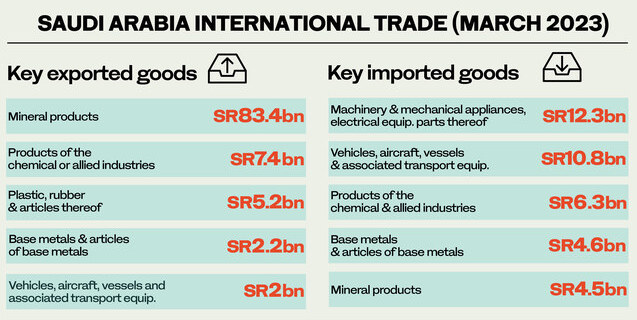The value of Saudi Arabia’s exported goods experiences a 4.4% increase, reaching $28 billion.
Riyadh, Saudi Arabia – According to the latest report released by the Kingdom’s General Authority for Statistics, Saudi Arabia witnessed a 4.4% increase in total merchandise exports in March, reaching SR106.1 billion ($28.29 billion), compared to SR101.1 billion in the previous month.
The report highlighted that, despite this positive monthly growth, the Kingdom’s overall merchandise exports experienced a year-on-year decline of 25.3% in March. The value of exports in the same month of 2022 amounted to SR142 million, significantly higher than the current figures.
The General Authority for Statistics (GASTAT) further elucidated that the year-on-year decrease in exports was primarily attributed to a decline in oil shipments, which fell by 26.5% in March, amounting to SR83.1 billion.
The report unveiled that the share of oil in Saudi Arabia’s total exports reduced from 79.6% in March 2022 to 78.3% in March 2023. This highlights the Kingdom’s ongoing efforts to diversify its economy and reduce its reliance on oil-related revenues.
In a separate report released in May by the Joint Organizations Data Initiative, it was revealed that Saudi Arabia’s crude oil exports saw a modest increase. The country’s crude oil exports rose by 68,000 barrels per day, reaching 7.52 million barrels per day (bpd) in March, compared to 7.45 million bpd in February.
However, the report emphasized that Saudi Arabia’s non-oil exports, which include re-exports, witnessed a year-on-year decline of 21% in March, amounting to SR23 billion. On a month-on-month basis, there was a notable increase of SR1.5 billion or 7.2% in non-oil exports.
The data suggests that while Saudi Arabia continues to face challenges in its overall export performance, efforts to diversify its economy beyond oil are yielding some positive results. The Kingdom’s commitment to boosting non-oil sectors and encouraging a more balanced trade portfolio reflects its long-term vision for economic growth and stability.
Saudi Arabia has been actively implementing various initiatives and reforms to enhance its non-oil sectors, including promoting industries such as manufacturing, petrochemicals, tourism, and renewable energy. These measures are aimed at creating a more resilient and diversified economy that can withstand fluctuations in global oil markets.
The General Authority for Statistics (GASTAT) emphasizes Saudi Arabia’s continuous efforts to diversify its economy and explore sectors beyond oil. In line with the Saudi Vision 2030, the share of oil in the country’s total exports decreased from 79.6% in March 2022 to 78.3% in March 2023. This demonstrates the Kingdom’s dedication to nurturing non-oil sectors and cultivating a more balanced trade ecosystem.
The Joint Organizations Data Initiative’s report, released in May, provides further insights into Saudi Arabia’s crude oil exports. The data reveals a modest increase, as crude oil exports rose by 68,000 barrels per day to 7.52 million barrels per day (bpd) in March, compared to 7.45 million bpd in February. Despite the challenges faced by the global oil market, this increase reflects the Kingdom’s commitment to maintaining a stable and reliable supply of crude oil.
In contrast to the decline in oil exports, Saudi Arabia’s non-oil exports, which include re-exports, experienced a year-on-year decline of 21% in March, amounting to SR23 billion. However, on a month-on-month basis, non-oil exports witnessed a notable increase of SR1.5 billion or 7.2%. This positive growth indicates the Kingdom’s progress in expanding and diversifying its non-oil sectors.
Saudi Arabia’s economic diversification efforts encompass a range of sectors, including manufacturing, petrochemicals, tourism, and renewable energy. The government has implemented various initiatives and reforms to attract foreign investment, foster innovation, and create an enabling business environment. These measures aim to build a robust and diversified economy capable of withstanding global economic fluctuations and reducing reliance on oil revenues.
As the Kingdom continues its economic transformation journey, the government’s focus on diversifying exports and reducing its dependence on oil revenues remains a key priority. Efforts to stimulate non-oil sectors and expand international trade relationships are crucial for sustaining long-term economic growth and ensuring a prosperous future for Saudi Arabia.





